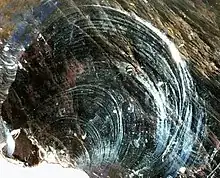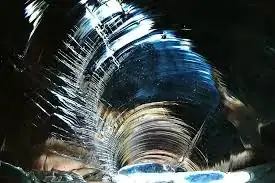When a crystalline material breaks, it often does so along planes in its crystalline structure. As such this is a result of its microscopic structure.
When glass breaks however, the shapes along which it breaks are typically very smooth as well, rather than being very irregular or jagged. Being amorphous, one shouldn't expect any smooth surfaces (of more than microscopic size) across which the atoms are bonding more weakly than in other direction to be present at all.
One possibility that I can think of is that real glass is locally crystalline, and some surfaces of weaker bonding are actually present in the material, and an ideal glass would behave differently.
Another possibility is that unlike in crystalline materials, this is not a result of its microscopic structure, but rather of its macroscopic structure namely its shape: when the glass is hit, it vibrates in a way that is constrained by its shape. We see that harmonic vibrations in a solid typically has very smooth shapes along which the amplitude is 0 (nodal patterns), like in Chladni plates
Does anyone know what is the actual reason?



